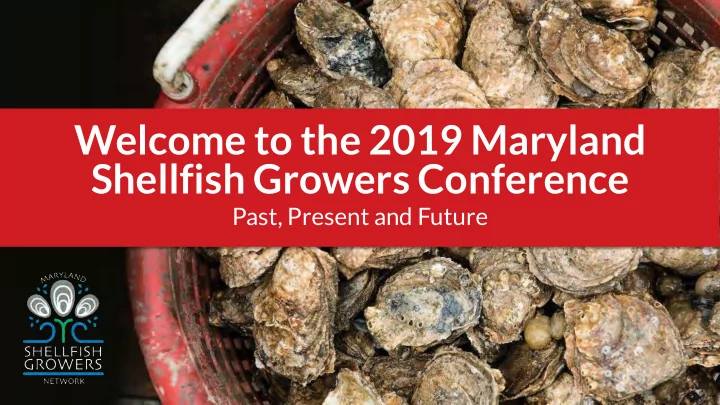

Welcome to the 2019 Maryland Shellfish Growers Conference Past, Present and Future
Shellfish Lease Laws 1830 – One Acre Law 1865 – Five Acre Law with General License 1906 – Haman Law; Oyster (Yates) Survey 1914 – Shepard Act allows protest without evidence or proof; many applications withdrawn 1972 – moratorium until Bay resurveyed (till 1983) 2009 – current lease law Era II 1930-1987 mandating active use Era I 1840-c. 1930 passed unanimously in Era III MD legislature History of Maryland Leasing Programs
• Frank Wilde, Shadyside – raising seed with MWA in crab floats • George Krantz, HPL – oyster raceways, hatchery production • DECD Dep Sec Bill Pate – M.O.R.E. Task Force Recommendations • DNR Dep Sec Lou Phipps – resurveying the NOBs in the Bay • Processing and Marketing • Financial Assistance Sources Oyster Culture in Maryland 1979
Survey of Industry Attending Conference • Production: 50-100 33%, 100-500 38%, 500-1500 14% • Harvesting: self 55%, hired 45% • Gear used: tongs 51%, dredge 41%, other 8% • Major constraints: seed source 27%, theft 18%, capital 17%, mortality 11%, bottom type 10%, poor growth 4%, market price 2%, market availability 0% • Future programs: yes 100% Oyster Culture in Maryland 1979
• Max Chambers, Nanticoke – running a commercial hatchery • Dexter Haven, VIMS – mechanization in oyster aquaculture • George Krantz, HPL and Sarah Otto, DNR – disease background and warnings • Mechanized Processing – Bob Prier, CBSIA and Bill Shaw, NOAA • Marketing – Giant Food and Red Lobster Inns • Bill Outten, DNR – Leasing update Oyster Culture in Maryland 1980
• Developed in Pacific Northwest • Introduced by Don Meritt in 1982 in demonstration project in Nanticoke • Equipment was placed on a trailer known as the “ Spatmobile ” and moved to many locations during the 1980s for demonstration workshops • Provided early development training for spat on shell production for annually planting leases • However, most Eastern Shore counties legislatively prevented from further leasing Remote Setting Introduced 1982
• MD Sea Grant – many research and Extension CLEARLY NEEDED……A MA MAJOR JOR CHANG ANGE E IN IN COURSE URSE projects funded over the years for oysters, aquaculture species and production systems • Horn Point Hatchery – solves many production problems; becomes largest output of native oysters for large-scale restoration and commercial development • VIMS – development of genetically improved lines, families and tetraploids spurs production • Oyster Recovery Partnership – formed from Oyster Roundtable; becomes key player for development of innovation in public resource restoration and aquaculture development Oyster Culture Development
August 2008 Governor O’Malley visits shellfish farms in the coastal bays and calls for revision of lease laws to spur aquaculture development May 2009 Lease law revision bill signed after unanimous passage by the General Assembly Revising Maryland’s Lease Law 2009
• Almost 7,000 acres leased – more coming, with both traditional bottom and new water column methods • Auxiliary businesses – equipment, coatings, products, food retailers, potential for nutrient credit trading • New gear and methods – variety of bottom cages, Canadian floats, Australian containers, others developed by making improvement • Maryland seen as a model – groups from other states and nations have come to see how our Aquaculture Association of results have worked; adopted some of them Nova Scotia visits Horn Point • Scientific interest – solutions for problems Response to Improved Lease Law
• Higher output production – adapt military and advanced robotics technology to culture systems to enhance production efficiency • Expanded genetics – continue expanding lines and families for higher meat quality, faster growth and disease resistance • Advanced processing – mechanized systems for removing meats and creating value-added products for modern markets • More finance sources – loans and grants for improved industry profitability Future Directions
Partners for Progress in Aquaculture
You ARE the Future…. With Your Vision and Hard Work Where will we be 40 years from NOW????
Recommend
More recommend